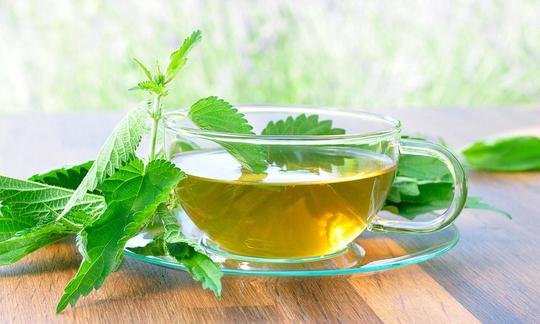Nettle Tea (Stinging Nettle Tea)
vegan
Ingredients (for servings, )
| 1 ⅓ tbsp | Nettles, large, raw (hemp nettles, organic?) (0.17 oz) |
| 500 ml | Drinking water, raw (organic?) (18 oz) |
Equipment
- stove
- saucepan
Type of preparation
- bring to a boil
Preparation
Boil the water in a saucepan or kettle.
If you like, you can also add a small piece of lemon with the peel to the water. The lemon gives the nettle tea a fresh flavor. And you benefit from the valuable nutrients found in the lemon peel.
Pour the boiling water over the nettle leaves.
To obtain a natural, subtle sweetness, you can brew the tea together with stevia leaves.
Let the nettle leaves steep for 5 to 10 minutes.
Five to 10 minutes is ideal as it allows enough time for the active substances to be released from the plant. Make sure that you hold to the recommended steeping time. If you steep the tea too long, it may have an overpowering or bitter flavor.
|
Nutritional Information per person
Convert per 100g
|
2000 kcal | ||
|---|---|---|---|
| Energy | 1.0 kcal | 0.1% | |
| Fat/Lipids | 0.00 g | 0.0% | |
| Saturated Fats | n/a | ||
| Carbohydrates (inc.dietary fiber) | 0.18 g | 0.1% | |
| Sugars | 0.01 g | 0.0% | |
| Fiber | 0.17 g | 0.7% | |
| Protein/Albumin | 0.06 g | 0.1% | |
| Cooking Salt (Na:10.1 mg) | 26 mg | 1.1% | |
| Essential micronutrients with the highest proportions | per person | 2000 kcal | |
|---|---|---|---|
| Vit | Vitamin K | 12 µg | 16.0% |
| Min | Fluorine, F | 178 µg | 5.0% |
| Min | Copper, Cu | 0.03 mg | 3.0% |
| Elem | Calcium, Ca | 19 mg | 2.0% |
| Min | Manganese, Mn | 0.02 mg | 1.0% |
| Sodium, Na | 10 mg | 1.0% | |
| Elem | Magnesium, Mg | 3.9 mg | 1.0% |
| Min | Zinc, Zn | 0.03 mg | < 0.1% |
| Vit | Vitamin B6 (pyridoxine) | 0.00 mg | < 0.1% |
| Vit | Niacin (née vitamin B3) | 0.01 mg | < 0.1% |
Detailed Nutritional Information per Person for this Recipe
The majority of the nutritional information comes from the USDA (US Department of Agriculture). This means that the information for natural products is often incomplete or only given within broader categories, whereas in most cases products made from these have more complete information displayed.
If we take flaxseed, for example, the important essential amino acid ALA (omega-3) is only included in an overarching category whereas for flaxseed oil ALA is listed specifically. In time, we will be able to change this, but it will require a lot of work. An “i” appears behind ingredients that have been adjusted and an explanation appears when you hover over this symbol.
For Erb Muesli, the original calculations resulted in 48 % of the daily requirement of ALA — but with the correction, we see that the muesli actually covers >100 % of the necessary recommendation for the omega-3 fatty acid ALA. Our goal is to eventually be able to compare the nutritional value of our recipes with those that are used in conventional western lifestyles.
| Vitamins | per person | 2000 kcal |
|---|---|---|
| Vitamin K | 12 µg | 16.0% |
| Riboflavin (vitamin B2) | 0.00 mg | < 0.1% |
| Niacin (née vitamin B3) | 0.01 mg | < 0.1% |
| Vitamin B6 (pyridoxine) | 0.00 mg | < 0.1% |
| Vitamin A, as RAE | 2.4 µg | < 0.1% |
| Folate, as the active form of folic acid (née vitamin B9 and | 0.34 µg | < 0.1% |
| Essential macroelements (macronutrients) | per person | 2000 kcal |
|---|---|---|
| Calcium, Ca | 19 mg | 2.0% |
| Magnesium, Mg | 3.9 mg | 1.0% |
| Sodium, Na | 10 mg | 1.0% |
| Phosphorus, P | 1.7 mg | < 0.1% |
| Potassium, K | 8.0 mg | < 0.1% |
| Essential trace elements (micronutrients) | per person | 2000 kcal |
|---|---|---|
| Fluorine, F | 178 µg | 5.0% |
| Copper, Cu | 0.03 mg | 3.0% |
| Manganese, Mn | 0.02 mg | 1.0% |
| Iron, Fe | 0.04 mg | < 0.1% |
| Zinc, Zn | 0.03 mg | < 0.1% |
| Selenium, Se | 0.01 µg | < 0.1% |
Nettle tea, or stinging nettle tea, is easy to prepare, and thanks to its diuretic effects it has many health benefits.
Where to find wild nettles: Nettles grow wild almost everywhere in the northern hemisphere. If you are picking them to make tea, you should avoid areas and places where there are dogs. Wear gloves to protect your hands when picking nettles.
Picking nettles: You can usually find nettle leaves from April until September. It is best to pick primarily young, tender nettles in the spring or nettles that still have a soft stem later in the year. These will taste the best. Cut the nettles off at one of their nodes and then strip the leaves off the stems from bottom to top. Wearing gloves makes picking nettles a lot easier, and then you can directly prepare and use the fresh nettles.
Drying nettles: Arrange the nettles into small bunches and let dry in a shady, dry, and well-ventilated place. Then tear off the leaves and store in a jar. The upper parts of the stem can also be used, but they should be dried long enough that they snap cleanly when bent. Cut the dried stems into smaller pieces so that the active substances can better be incorporated into the tea water.
Dehydrate, detoxify, purify: Nettle tea stimulates the kidneys to produce more urine, allowing toxins to escape from the body more quickly. As a detox cure, you can drink one to three cups of nettle tea per day for four to a maximum of six weeks.
Prostate, bladder, kidney “gravel”: Thanks to its antibacterial effects, nettle tea can help to kill bacteria that causes inflammation. The dehydrating effects also cause the bacteria to be flushed out. In addition, nettle tea can be helpful in the prevention of kidney “gravel” (small kidney stones). You can drink several cups of freshly brewed nettle tea throughout the day.
Pregnancy: Pregnant women should not drink nettle tea as its diuretic effects can cause excretion to be higher than the daily fluid intake. Regular consumption may cause physical changes in a pregnant woman that may have a harmful effect on the unborn child.
Overdose: Nettle tea is generally considered to have very few side effects. But if the heart or kidney function is impaired, an overdose can overtax the body or lead to mild nausea and disorders of the gastrointestinal tract. These side effects result from the diuretic effects of the tea. In very rare cases, nettle tea can trigger allergic reactions that manifest as an itchy skin rash. The general recommendation is to drink three cups of nettle tea per day. If you drink nettle tea over a longer period of time, you should regularly take a day where you don’t drink any at all.
Steeping time: Five to 10 minutes is ideal as it allows enough time for the active substances to be released from the plant. If you steep the tea too long, it may have an overpowering or bitter flavor.
Tea mix: Adding other herbs and/or fruits improves the color and flavor of nettle tea. For example, it goes well with chamomile, fennel, rose hip, or peppermint. You get obtain a natural sweetness by adding stevia leaves. Adding fresh lemon juice or brewing the tea together with a lemon peel can also enhance the flavor of nettle tea.
Fresh or dried: In the spring, it is best to use young nettle stems and leaves to make nettle tea. As the plant matures, the concentration of oxalate crystals increases. You should therefore stock up on young, dried nettle leaves in the spring, or alternatively you can buy dried leaves at health food stores or specialty tea shops.
Dwarf nettles: You can also use the same amount of dwarf nettles (Urtica urens) in place of stinging nettles (Urtica dioica).




